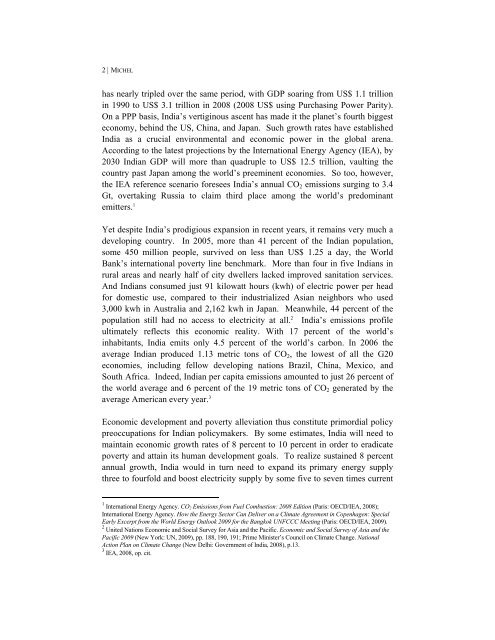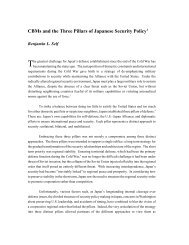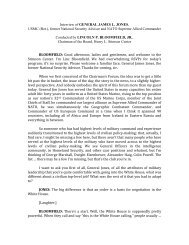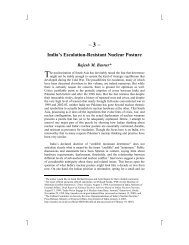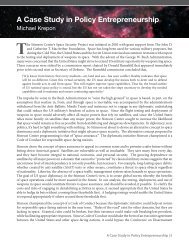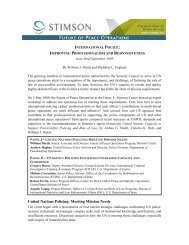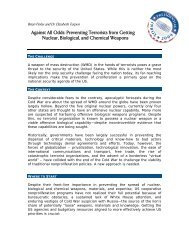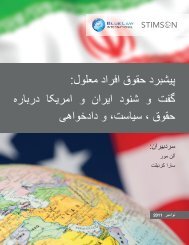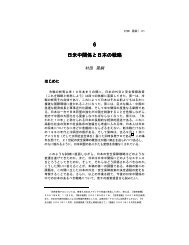Indian Climate Policy: Choices and Challenges - The Stimson Center
Indian Climate Policy: Choices and Challenges - The Stimson Center
Indian Climate Policy: Choices and Challenges - The Stimson Center
You also want an ePaper? Increase the reach of your titles
YUMPU automatically turns print PDFs into web optimized ePapers that Google loves.
2 | MICHEL<br />
has nearly tripled over the same period, with GDP soaring from US$ 1.1 trillion<br />
in 1990 to US$ 3.1 trillion in 2008 (2008 US$ using Purchasing Power Parity).<br />
On a PPP basis, India’s vertiginous ascent has made it the planet’s fourth biggest<br />
economy, behind the US, China, <strong>and</strong> Japan. Such growth rates have established<br />
India as a crucial environmental <strong>and</strong> economic power in the global arena.<br />
According to the latest projections by the International Energy Agency (IEA), by<br />
2030 <strong>Indian</strong> GDP will more than quadruple to US$ 12.5 trillion, vaulting the<br />
country past Japan among the world’s preeminent economies. So too, however,<br />
the IEA reference scenario foresees India’s annual CO 2 emissions surging to 3.4<br />
Gt, overtaking Russia to claim third place among the world’s predominant<br />
emitters. 1<br />
Yet despite India’s prodigious expansion in recent years, it remains very much a<br />
developing country. In 2005, more than 41 percent of the <strong>Indian</strong> population,<br />
some 450 million people, survived on less than US$ 1.25 a day, the World<br />
Bank’s international poverty line benchmark. More than four in five <strong>Indian</strong>s in<br />
rural areas <strong>and</strong> nearly half of city dwellers lacked improved sanitation services.<br />
And <strong>Indian</strong>s consumed just 91 kilowatt hours (kwh) of electric power per head<br />
for domestic use, compared to their industrialized Asian neighbors who used<br />
3,000 kwh in Australia <strong>and</strong> 2,162 kwh in Japan. Meanwhile, 44 percent of the<br />
population still had no access to electricity at all. 2 India’s emissions profile<br />
ultimately reflects this economic reality. With 17 percent of the world’s<br />
inhabitants, India emits only 4.5 percent of the world’s carbon. In 2006 the<br />
average <strong>Indian</strong> produced 1.13 metric tons of CO 2 , the lowest of all the G20<br />
economies, including fellow developing nations Brazil, China, Mexico, <strong>and</strong><br />
South Africa. Indeed, <strong>Indian</strong> per capita emissions amounted to just 26 percent of<br />
the world average <strong>and</strong> 6 percent of the 19 metric tons of CO 2 generated by the<br />
average American every year. 3<br />
Economic development <strong>and</strong> poverty alleviation thus constitute primordial policy<br />
preoccupations for <strong>Indian</strong> policymakers. By some estimates, India will need to<br />
maintain economic growth rates of 8 percent to 10 percent in order to eradicate<br />
poverty <strong>and</strong> attain its human development goals. To realize sustained 8 percent<br />
annual growth, India would in turn need to exp<strong>and</strong> its primary energy supply<br />
three to fourfold <strong>and</strong> boost electricity supply by some five to seven times current<br />
1 International Energy Agency. CO2 Emissions from Fuel Combustion: 2008 Edition (Paris: OECD/IEA, 2008);<br />
International Energy Agency. How the Energy Sector Can Deliver on a <strong>Climate</strong> Agreement in Copenhagen: Special<br />
Early Excerpt from the World Energy Outlook 2009 for the Bangkok UNFCCC Meeting (Paris: OECD/IEA, 2009).<br />
2 United Nations Economic <strong>and</strong> Social Survey for Asia <strong>and</strong> the Pacific. Economic <strong>and</strong> Social Survey of Asia <strong>and</strong> the<br />
Pacific 2009 (New York: UN, 2009), pp. 188, 190, 191; Prime Minister’s Council on <strong>Climate</strong> Change. National<br />
Action Plan on <strong>Climate</strong> Change (New Delhi: Government of India, 2008), p.13.<br />
3 IEA, 2008, op. cit.


